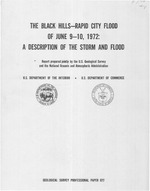The Black Hills-Rapid City flood of June 9-10, 1972: A description of the storm and flood
Links
- Document: Report (pdf)
- Download citation as: RIS | Dublin Core
Abstract
On June 9, 1972, an almost stationary group of thunderstorms formed over the eastern Black Hills of South Dakota near Rapid City and produced record amounts of rainfall and flood discharges. Nearly 15 inches of rain fell in about 6 hours near Nemo, S. Dak., and more than 10 inches of rain fell over a 60-square-mile area. The resulting floods were the highest ever recorded in South Dakota. At least 18 of the 27 streams where peak flows were computed experienced flows that exceeded the 50-year flood.
At least 237 people died in the Black Hills flood and 8 people were still listed as missing 6 months after the flood. Another 3,057 people were injured, and total damage is estimated to have exceeded $160 million.
As documented by radar and' satellite images and by radiosonde observations, as well as by much other weather data, the unusual and excessive rainfall was partly the result of a strong, low-level, easterly airflow that forced moist air upslope over the Black Hills. This sustained orographic effect helped the air to rise, cool, become very unstable, and release its moisture in repeating -thunderstorms. Another important contributing factor was the unusually light winds at higher levels. Those light winds did not disperse the moist air or move the thunderstorms along to prevent the extreme concentration of rainfall. Instead, these conditions allowed heavy rainfall to remain almost stationary along the eastern slopes of the Black Hills.
Rainfall data from 24 observing stations and from over 200 miscellaneous sites show that all reported rains greater than 4 inches fell on the eastern slopes of the Black Hills. At least 6 inches of rain fell over a 300-square-mile area that lies primarily between 4,000 and 5,000 feet elevation.
Almost all the flood peaks occurred between 2230 MDT on June 9 and 0100 MDT on June 10, 1972, in a flood belt about 40 miles long and 20 miles wide along the eastern slopes of the Black Hills. This belt extended from Sturgis, S. Dak., on the north to Hermosa, S. Dak., on the south, with Rapid City near the center. To document the flood, peak discharge determinations were made at 49 sites. Records show that about 13,000 acre-feet of water flowed through Rapid City during the 2 days of flooding. At one point during the night of June 9, the floodwaters rose about 3.5 feet in 15 minutes. Coming off the slopes of the Black Hills, the flood peak traveled the 22 miles between Deer Creek and Rapid City in about 3.5 hours.
Study Area
| Publication type | Report |
|---|---|
| Publication Subtype | USGS Numbered Series |
| Title | The Black Hills-Rapid City flood of June 9-10, 1972: A description of the storm and flood |
| Series title | Professional Paper |
| Series number | 877 |
| DOI | 10.3133/pp877 |
| Year Published | 1975 |
| Language | English |
| Publisher | U.S. Government Printing Office |
| Publisher location | Washington, D.C. |
| Contributing office(s) | South Dakota Water Science Center, Dakota Water Science Center |
| Description | vi, 47 p. |
| Country | United States |
| State | South Dakota |
| City | Rapid City |
| Other Geospatial | Black Hills |
| Online Only (Y/N) | N |
| Additional Online Files (Y/N) | N |


